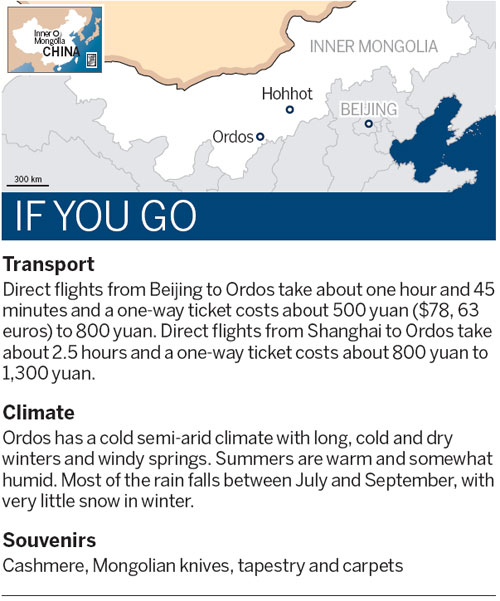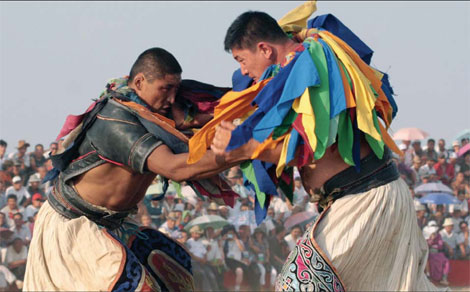Games of the Khan
Updated: 2012-07-06 07:50
(China Daily)
|
||||||||
|
Mongolian wrestling is different from other forms of Chinese wrestling. Wu Changqing / For China Daily |
Mongolian festival celebrates time-honored skills, entertainment on the steppes
Among the many diverse cultures of China's ethnic groups, Mongolians stand out for their herding and nomadic traditions. And amid the country's fast-paced development and urbanization, members of the group still maintain their proud customs and habits of the grasslands and steppes by holding one of their most popular festivals - Naadam.
Held in the Inner Mongolia autonomous region during midsummer when the grasslands are lush and the livestock fully grown, Naadam alludes to "entertainment" or "game" in the Mongolian language.
The Mongol leader Genghis Khan himself is believed to have thought up the games involving wrestling, archery and horse racing in the 13th century to emphasis the traits needed for a Mongolian soldier.
Naadam has since evolved to encompass and gauge the character and capabilities of the Mongolians.
"The three games of men" provide an eye-popping and exhilarating way for those weary of city life or the typical scenic and historic spot to get in touch with their outdoor side.
The Second Ordos International Naadam Fair, touted as the biggest of its kind in China, starts on Aug 27 in Ordos in Inner Mongolia and lasts till Sept 3. This annual event will consist of 16 sporting competitions, art and cultural activities, exhibitions and trade shows. Here are some of the highlights:
1. Horse racing
Horses are deeply embedded in Mongolian culture. Riding them is an indication of a man's skills, so horse racing is probably the most exciting game during Naadam. Herdsmen from hundreds of miles away ride their horses to attend the festival.
Decked in colorful waistbands and head cloths, riders, triggered by the sound of the horn, saddle up and gallop away with spectators rallying near the starting point. Tourists will find the deafening cheers of the crowd accompanying the thundering hooves of the horses unforgettable.
The horse is the center of attention. When the race is completed, an elderly man usually goes up to the champion mount with a hada (a piece of silk used as a greeting gift) on both hands, reciting compliments for the winner. Every part of the beast's body will be praised. After that, the hada will be attached to the horse's neck.
Tourists can also gather at the finishing line to try for a touch of the horses as they pass. According to Mongolian legend, the sweat of the fastest horses is considered good luck for the coming year.
2. Mongolian wrestling
Mongolian wrestling is the herdsmen's favorite sport. Called "Boekh", which means "durability" in Mongolian, it is uniquely Mongolian and is distinctly different from other forms of Chinese wrestling and Japanese sumo in terms of match rules, costumes and settings.
Once the match starts, wrestlers immediately try to grab the upper body of his opponent. Any body part other than the feet hitting the ground signals defeat. Anyone who hopes to win the game has to rely on dexterity rather than strength. The rules mandate that the contestants should not in any way pull the trousers of the opponents.
There is no limit on time or weight. The wrestlers have to be grouped in even numbers.
Referees pick competitors and wrestlers have no right to choose their opponents. Specific costumes must be worn during the event. Wrestlers put on loose-fitting white trousers with animal or flower-embroidered leggings. Jackets are made of leather studded with silver or bronze rivets.
A red, blue and yellow silk three-color waistband covers the middle part of the body, and leather boots are also worn to reinforce players' moves.
Renowned wrestlers also wear a jangga, a necklace made of strands of colorful silk ribbons. This is only awarded to those who have risen up the ranks during the contests.

3. Archery
The reign of Genghis Khan in the 13th century required adult Mongolian men to perform military service, with archery becoming a fundamental skill for the soldiers.
After the Khan conquered most parts of the Euro-Asian continent, many hunting and nomadic tribes started returning to herding. But they also maintained their archery skills in case of attacks from wild animals or enemies.
Two different kinds of archery are contested during Naadam: stationary shooting and shooting on horseback.
In stationary shooting, every man shoots nine arrows in three turns and the top three hitting the bull's eye most will be awarded. For horseback archery, targets are erected 25 meters between each one. Every rider can shoot three times at each target. The contestant has to finish his shooting within the lanes set. If there are arrows left after the horse runs the whole length, it will be deemed dishonorable.
Besides these traditional games, an international marathon will take place during the Naadam this year. Another highlight of the fair includes the 62nd Miss World Final during the festivities. Hiashatar, a form of Mongolian chess competition, will take place during the fair.
China Daily

 Relief reaches isolated village
Relief reaches isolated village
 Rainfall poses new threats to quake-hit region
Rainfall poses new threats to quake-hit region
 Funerals begin for Boston bombing victims
Funerals begin for Boston bombing victims
 Quake takeaway from China's Air Force
Quake takeaway from China's Air Force
 Obama celebrates young inventors at science fair
Obama celebrates young inventors at science fair
 Earth Day marked around the world
Earth Day marked around the world
 Volunteer team helping students find sense of normalcy
Volunteer team helping students find sense of normalcy
 Ethnic groups quick to join rescue efforts
Ethnic groups quick to join rescue efforts
Most Viewed
Editor's Picks

|

|

|

|

|

|
Today's Top News
Chinese fleet drives out Japan's boats from Diaoyu
Health new priority for quake zone
Inspired by Guan, more Chinese pick up golf
Russia criticizes US reports on human rights
China, ROK criticize visits to shrine
Sino-US shared interests emphasized
China 'aims to share its dream with world'
Chinese president appoints 5 new ambassadors
US Weekly

|

|







